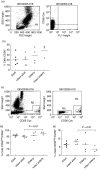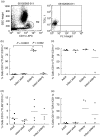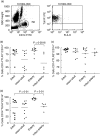Ageing and Toll-like receptor expression by innate immune cells in chronic human schistosomiasis
- PMID: 17488296
- PMCID: PMC1941952
- DOI: 10.1111/j.1365-2249.2007.03403.x
Ageing and Toll-like receptor expression by innate immune cells in chronic human schistosomiasis
Abstract
There has been no systematic study of the immune response of individuals aged over 60 years living in Schistosomiasis mansoni-endemic areas, although senescence is reportedly associated with susceptibility to infection and progressive decline in immune function. We have shown previously, in two endemic areas in Minas Gerais, Brazil, that the frequency of individuals aged over 60 years with chronic schistosomiasis is no longer negligible. Moreover, several elderly individuals who have always lived in these endemic areas stay protected from infection. An important question for studies of ageing and disease control in developing countries is which differences in the immunological profile of these negatively tested (non-infected) individuals can account for their resistance to either infection or reinfection. We show, in the present study, that non-infected (negative) elderly individuals develop innate immune mechanisms of protection that replace the age-associated decline in T cell function. Non-infected elderly individuals from endemic areas of schistosome infection present an increase in the frequency of the natural killer (NK) CD56(low) subset of NK cells expressing Toll-like receptors (TLR)-1, -2, -3 and -4 as determined by flow cytometry analysis. In addition, the proportion of dendritic cells expressing TLR-1 is elevated as well as the frequency of monocytes expressing TLR-1 and -4. These results suggest that TLR expression by cells of the innate immune system may be related to the negative status of infection in some elderly individuals who are constantly exposed to S. mansoni. Developing mechanisms of protection from infection may represent a biomarker for healthy ageing in this population.
Figures






Similar articles
-
Aging and immune response in chronic human schistosomiasis.Acta Trop. 2008 Nov-Dec;108(2-3):124-30. doi: 10.1016/j.actatropica.2008.05.004. Epub 2008 May 18. Acta Trop. 2008. PMID: 18582841 Review.
-
Production of interferon-gamma by natural killer cells and aging in chronic human schistosomiasis.Mediators Inflamm. 2004 Dec;13(5-6):327-33. doi: 10.1080/09629350400008802. Mediators Inflamm. 2004. PMID: 15770048 Free PMC article.
-
A 13-year follow-up of treatment and snail control in an area endemic for Schistosoma mansoni in Brazil: incidence of infection and reinfection.Bull World Health Organ. 1993;71(2):197-205. Bull World Health Organ. 1993. PMID: 8490983 Free PMC article.
-
A specific Toll-like receptor profile on T lymphocytes and values of monocytes correlate with bacterial, fungal, and cytomegalovirus infections in the early period of allogeneic stem cell transplantation.Transpl Infect Dis. 2014 Oct;16(5):697-712. doi: 10.1111/tid.12264. Epub 2014 Jul 12. Transpl Infect Dis. 2014. PMID: 25040166
-
Human schistosomiasis mansoni: immune responses during acute and chronic phases of the infection.Acta Trop. 2008 Nov-Dec;108(2-3):109-17. doi: 10.1016/j.actatropica.2008.05.027. Epub 2008 Jun 5. Acta Trop. 2008. PMID: 18577364 Review.
Cited by
-
Immune Mechanisms Involved in Schistosoma mansoni-Cathepsin B Vaccine Induced Protection in Mice.Front Immunol. 2018 Jul 25;9:1710. doi: 10.3389/fimmu.2018.01710. eCollection 2018. Front Immunol. 2018. PMID: 30090103 Free PMC article.
-
Living in endemic area for infectious diseases is associated to differences in immunosenescence and inflammatory signatures.Front Immunol. 2025 Mar 17;16:1547854. doi: 10.3389/fimmu.2025.1547854. eCollection 2025. Front Immunol. 2025. PMID: 40165959 Free PMC article.
-
Association of MICA gene polymorphisms with liver fibrosis in schistosomiasis patients in the Dongting Lake region.Braz J Med Biol Res. 2012 Mar;45(3):222-9. doi: 10.1590/s0100-879x2012007500024. Epub 2012 Mar 1. Braz J Med Biol Res. 2012. PMID: 22370708 Free PMC article.
-
Health-and disease-related biomarkers in aging research.Res Gerontol Nurs. 2009 Apr;2(2):137-48. doi: 10.3928/19404921-20090401-09. Res Gerontol Nurs. 2009. PMID: 20077975 Free PMC article.
-
Probiotic modulation of dendritic cell function is influenced by ageing.Immunobiology. 2014 Feb;219(2):138-48. doi: 10.1016/j.imbio.2013.08.012. Epub 2013 Sep 5. Immunobiology. 2014. PMID: 24094416 Free PMC article.
References
-
- Webster M, Roberts M, Fulford AJ, et al. Human IgE responses to rSm22·6 are associated with infection intensity rather than age per se, in a recently established focus of Schistosomiasis mansoni. Trop Med Int Health. 1998;3:318–26. - PubMed
-
- Bethony J, Williams JT, Kloos H, et al. Exposure to Schistosoma mansoni infection in a rural area in Brazil. II. Household risk factors. Trop Med Int Health. 2001;6:136–45. - PubMed
-
- Malaguarnera L, Ferlito L, Imbesi R, et al. Immunosenescence: a review. Arch Gerontol Geriatr. 2001;32:1–14. - PubMed
-
- Pawelec G, Solana R. Immunoageing − the cause or effect of morbidity. Trends Immunol. 2001;22:348–9. - PubMed
Publication types
MeSH terms
Substances
LinkOut - more resources
Full Text Sources
Medical
Research Materials

